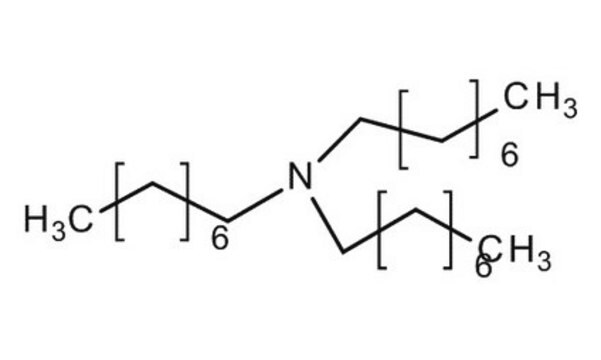おすすめの製品
グレード
technical grade
蒸気圧
8 mmHg ( 135 °C)
アッセイ
70%
組成
primary amine, >98%
屈折率
n20/D 1.4596 (lit.)
bp
348-350 °C (lit.)
mp
18-26 °C (lit.)
密度
0.813 g/mL at 25 °C (lit.)
SMILES記法
[H]\C(CCCCCCCC)=C(/[H])CCCCCCCCN
InChI
1S/C18H37N/c1-2-3-4-5-6-7-8-9-10-11-12-13-14-15-16-17-18-19/h9-10H,2-8,11-19H2,1H3/b10-9-
InChI Key
QGLWBTPVKHMVHM-KTKRTIGZSA-N
類似した製品をお探しですか? 訪問 製品比較ガイド
詳細
アプリケーション
シグナルワード
Danger
危険有害性の分類
Acute Tox. 4 Oral - Aquatic Acute 1 - Aquatic Chronic 1 - Asp. Tox. 1 - Eye Dam. 1 - Skin Corr. 1B - STOT RE 2 - STOT SE 3
ターゲットの組織
Respiratory system
保管分類コード
8A - Combustible corrosive hazardous materials
WGK
WGK 3
引火点(°F)
309.2 °F - closed cup
引火点(℃)
154 °C - closed cup
個人用保護具 (PPE)
Eyeshields, Faceshields, Gloves, type P3 (EN 143) respirator cartridges
適用法令
試験研究用途を考慮した関連法令を主に挙げております。化学物質以外については、一部の情報のみ提供しています。 製品を安全かつ合法的に使用することは、使用者の義務です。最新情報により修正される場合があります。WEBの反映には時間を要することがあるため、適宜SDSをご参照ください。
PRTR
第一種指定化学物質
消防法
第4類:引火性液体
第三石油類
危険等級III
非水溶性液体
労働安全衛生法名称等を表示すべき危険物及び有害物
名称等を表示すべき危険物及び有害物
労働安全衛生法名称等を通知すべき危険物及び有害物
名称等を通知すべき危険物及び有害物
Jan Code
O7805-500G:
O7805-VAR:
O7805-BULK:
O7805-100G:
O7805-5G:
この製品を見ている人はこちらもチェック
資料
Solvothermal synthesis is a method for preparing a variety of materials such as metals, semiconductors, ceramics, and polymers.
Professor Randal Lee (University of Houston, USA) discusses design considerations for iron oxide magnetic nanospheres and nanocubes used for biosensing, including synthetic procedures, size, and shape. The effects of these variables are discussed for various volumetric-based and surface-based detection schemes.
Professor Randal Lee (University of Houston, USA) discusses design considerations for iron oxide magnetic nanospheres and nanocubes used for biosensing, including synthetic procedures, size, and shape. The effects of these variables are discussed for various volumetric-based and surface-based detection schemes.
ライフサイエンス、有機合成、材料科学、クロマトグラフィー、分析など、あらゆる分野の研究に経験のあるメンバーがおります。.
製品に関するお問い合わせはこちら(テクニカルサービス)















